 Australia : native food from the bush and also from the city.~~~~~~~~~~~ ~~~~~~~~~~~~~~~~~~~ Australia : native food from the bush and also from the city.~~~~~~~~~~~ ~~~~~~~~~~~~~~~~~~~aussi cooking -bush tucker. The most common methods are roasting on the coals, cooking in the ashes, steaming in a ground oven and boiling.All types of dampers, seeds, nuts and root vegetables are cooked in the hot ashes. It is important to select good wood for this cooking fire; many Australian native bushes have slightly irritant properties and some ashes are never used by Aborigines for cooking. Acacias are safe and fast burning. -----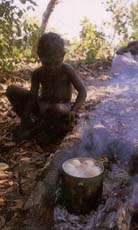 ----------------------------------------burdekin plum ----------------------------------------burdekin plum
The fruit can be eaten raw, or used in jams and jellies. Fruits tend to be very acid
Two types are known - one has red flesh, the other has green.burdekin plum] green.burdekin plum]
-----------------------------------------------
Bunya cone: This plant is a large tall tree to 40 m high with a straight trunk, prickly leaves, and separate male and female flowers. The female cones, up to 300 mm long and weighing up to 10 kg, contain the edible seeds. A large harvest occurs approximately every three years, January to March. The fruit was eaten raw, roasted, or pounded to flour to make a kind of bread.
Today, the nuts can still be eaten raw when fresh, or boiled to make it easier to extract the nut from the hard shell. The nuts can then be sliced or pureed and added to desserts and savoury dishes. The nuts' flour can also be used to make breads and cakes.
--------------------------------------------------
-
Riberry, Small leafed lillypilly,
Cherry Satinash.White terminal flowers in late spring or early summer are followed by masses of bright red pear-shaped fruit to about 1cm long.  -------------------------------------------- It is an appealing plant
Aboriginal name: Ooray. Common Name: Davidson's Plum
A small, narrow, rainforest tree which bears an edible, 50 mm long plum-like fruit with a purple-black skin. The large leaves to 800 mm long have many leaflets, each up to 250 mm long. The varieties found in North Queensland are different from those found in Southern Queensland and Northern NSW.The fruit has dark red flesh with a sour plum flavour. It is unpleasantly acid when raw. However this is an important fruit in the modern bushfood industry. The fruit flesh's colour makes it attractive as an additive. It is used to make jam and wine, and to provide colouring and flavouring in sauces, icecreams and drinks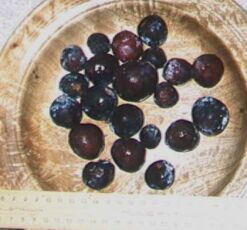 . .
-----------------------------------------------Lemon Myrtle is a bushy Queensland rainforest tree to about 8m, having dark green lemon-scented leaves to 100 mm long. It flowers prolifically with large bunches of small white flowers on the ends of the branches.The leaves are used fresh or dried & ground and have a lemon & lime oil flavour. They can be used with baked fish, to make a lemon tea, breads and cheesecakes etc., chicken and rice dishes, and sauces.
BACKHOUSIA CITRIODORA RECIPES
Coutesy: Colleen and Geoff Keena
In summer I drink either water or lemon myrtle drink:
4 large lemon myrtle leaves
Pour over boiling water. Let cool for at least an hour until liquid is the colour of tea.
Add to a 2 litre bottle of cold water for a refreshing drink.
You can keep adding cold water to the leaves for several days and drinking the resulting drink each day.
1/2 leaf
Pour over boiling water
Drink hot. Add a roughly shredded leaf to cook rice to accompany a curry.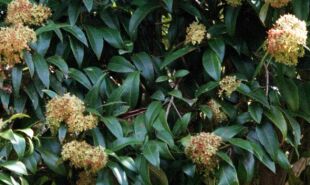 -----------------------------------------------candle nut;
This plant is a large rainforest tree with a spreading crown. It has large leaves.The nuts can be poisonous when raw, causing violent vomitingRoasting destroys the toxin in the oil which causes these effects. The roasted nuts are delicious, and are reported to be nutritious and high in energy from the fat they contain. They can be used to tenderise meat.
It is used in Indonesian cooking - usually ground to a paste. 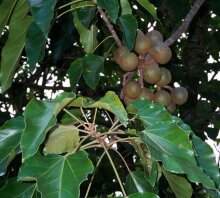 ----------------------------------------
Aboriginal Name: Midyim
This is a small rambling shrub with pointed leaves to 25 mm long, and which usually grows in sandy soil. Small white flowers are followed by round, blue-grey spotted fruits to 10 mm which ripen in autumn.The midyim fruits were gathered and eaten fresh by aborigines. They have a pleasant, slightly aromatic taste. Bushfood fans still relish the fruit today.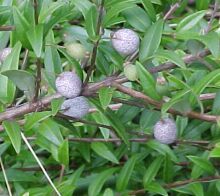
--------------------------------------------- Botanical name: Castanospermum australe
Common names: Black Bean, Moreton Bay Chestnut.
The first common name refers to the appearance of the fruit, a large woody pod to 200 mm long which at maturity is brown, but goes black on the ground after some time. The second refers to the chestnut taste of the treated seeds. This is a large majestic rainforest tree, common in the rainforests of Queensland and northern NSW. It bears clusters of red and yellow flowers in spring or early summer. The large leaves have numerous dark green leaflets which are about 120 mm long.
Usage
The starchy seeds of this tree are poisonous, but were eaten by the aborigines after considerable preparation.
The Moreton Bay Chestnut seeds were cracked and soaked in water, then pounded , and made into cakes, and finally roasted. The washing in water removes some of the soluble toxins, while roasting 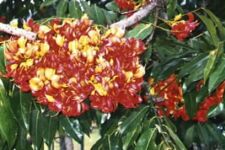 destroys other toxins. destroys other toxins.
-------------------------------------------
Common Name: Creek sandpaper fig
This is a bushy tree with rough, sandpapery leaves. The 20 mm furry fruit are dark when ripe, and appear on the trunk and larger branches. The tree is often associated with creek banks.
Usage
The fruit are edible raw when fully ripe, but the furry skin can be irritant, and must be 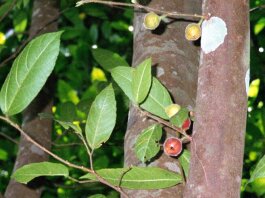 peeled off first.---- peeled off first.----
-------------------------------------------
Tetragonia tetragonoides
Common Names: Warrigal Greens, NZ spinach (It also grows in New Zealand)
This is a herb with arrow shaped leaves.
Photo courtesy Dot Crane Warrigal Greens have a spinach flavour. Their uses are as for spinach & Asian greens. They are also used in quiches and stuffings.
However, caution must be taken. Like some other edible plants, Warrigal Greens have a high oxalate concentration. Only leaves and young stems should be eaten and these both should be blanched for 3 minutes to remove soluble oxalates, and the water discarded. 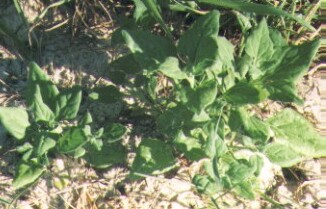 WARRIGAL GREENS PIE (rice base)
Rice (extra tasty if rice is cooked in coconut cream)
(we use coconut milk powder and add it to the rice as it is being cooked in the microwave - not low-fat but delicious)
Greased dish - I used an oval dish 27 cm x 19 cm and 5 cm deep.
4 eggs, beaten with 1/2 cup low-fat milk
grated low fat cheese
blanched warrigal green leaves
Put a layer of rice into the bottom of the dish, patting down firmly until layer is about 2 cm thick
Cover rice with a thick layer of fat-reduced grated cheese
. Then place a layer of blanched Warrigal Greens so cheese is completely covered.
Pour over the eggs beaten with low-fat milk
. Add another layer of grated low-fat cheese to finish off. We cooked it in the microwave for 5 minutes on high and 10 minutes on medium.
It was delicious both hot and cold. I garnished with lemon myrtle leaves and flowers and native hibiscus blooms. ---------------------------------------------
Name: Rubus sp.
The native raspberries are small to medium prickly shrubs, some being scramblers. The photograph shows Rubus moluccanus also known as Rubus hillii. This species has a metallic sheen on the underside of the leaf. It bears white flowers followed by 10 mm red berries in spring to summer.
---------------------------------------------
Cedar Bay Cherry is also known as Beach Cherry. This is a shrub to 4 m with a typical lilly pilly appearance. The leaves are thick textured. The small white flowers are followed by bright red fruit to 15 mm diameter. The flesh is white and the fruit has 1 or 2 seeds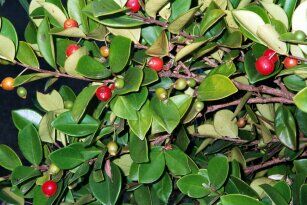 . The fruit is sweet tasting and can be eaten fresh. This is one of Australia's best fresh fruits. . The fruit is sweet tasting and can be eaten fresh. This is one of Australia's best fresh fruits.
---------------------------------------------- Common Name: Native Ginger
Plant is clumping and consists of soft, thick stems arising from an underground rhizome. The plant grows to about 2m and likes plenty of water, and likes some shade. The large bright green leaves are up to 400 mm long. The white flowers are followed by round blue fruits to 15 mm in spikes on the ends of the stems.
Usage
The pith inside the fruit has a pleasant, refreshing, lemony taste. Young root tips are edible. The leaves were also used by aborigines to lay under meat cooked in an earth oven. 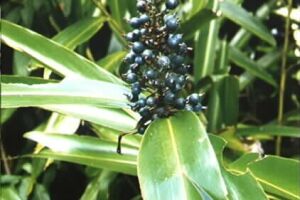
--------------------------------------------------------------------------------
bush tomato (Akadura) Solanum centrale, Davidson's Plum, Illawarra Plums, Kakadu Plums, Lemon Aspen, Munthari, Quandong, Riberry, Wild Limes, Lemon Myrtle, Aniseed Myrtle, Mountain Pepperleaf, Native Mint, Native Thyme, Native Pepperberries, Warrigal greens, Bunya Nuts, Macadamia Nuts, Wattleseed ------------------------------------
an important staple of the Kooris of Victoria. It is a small herbaceous plant with yellow daisy-like flowers. The Murnong is one of the tastiest of the original staple foods and should be cultivated as a cold climate vegetable -Microseris lanceolata: Murnong or Yam Daisy
------------------------------------------- Billardiera spp(Apple berry vine),These are climbing plants which tend to scramble among the branches of other forest or woodland The fruit of the Apple berry has a sweet, more-ish flavour, highly variable from one species to the next but usually falling between aniseed to kiwi fruit in taste. The natural habitat of this small vine is open forests of the south east regions of Australia.species.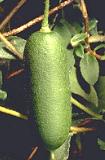
---------------------------------------------
There are three wild bush fruits commonly called a Quandong, the Desert Quandong is the fruit- Desert Quandong (Santulum acuminatum),The Desert Quandong, being Sandalwood is a non-obligate root parasite, that is the tree obtains its nutrients from other tree roots. When young the sandalwoods will utilise grass roots. It is not only the fruit, which is used from the tree; the kernel is also used as a food and for decorative uses..The fruits are shiny red and sometimes yellow 2 - 3 cm in diameter. The Desert Quandong grows in woodlands on sandy and stony soils. In the northern territory the Desert Quandong is becoming scarce most likely as a result of camel grazing.
Aborigines often ate the nutritious oily kernels of the Quandong. Some trees produce sweet almond flavoured kernels while others produce a distasteful kernel. The distaste in some kernels is a result a pungent aromatic oil, methyl benzoate. The seeds of the Quandong, both Desert and Bitter are round, pale and knobbly. |
 Free Forum Hosting
Free Forum Hosting